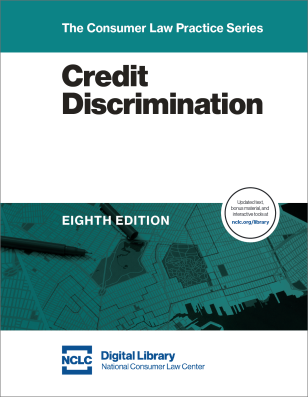Overview
Recent federal agency attempts to limit the power of credit discrimination statutes (including a September 3, 2020, Fair Housing Act rule) serve to underscore the effectiveness of credit discrimination statutes in remedying marketplace misconduct affecting communities of color and vulnerable consumers. Whether used to target predatory lending, differential pricing, aggressive collection tactics, or credit evaluation, these statutes taken as a whole allow for a choice of federal or state court, punitive and emotional distress damages, and attorney fees. With the national conversation concerning racial justice, the statutes are even more relevant today.
This article surveys federal and state credit discrimination statutes and describes why they belong in every consumer attorney’s toolbox. Links to NCLC’s Credit Discrimination treatise are provided for more detail. The article then addresses the new September 3 rule, which severely restricts Fair Housing Act (FHA) disparate impact claims. Disparate impact claims under the FHA can apply to rental housing, home insurance, and home sales. At least for now, disparate impact claims under the Equal Credit Opportunity Act (ECOA) are not so restricted. Thus, ECOA claims will be the preferred route to raise disparate impact claims in credit practices, including home mortgage lending.
Power of Credit Discrimination Statutes
A number of federal statutes address credit discrimination. The ECOA applies broadly to credit discrimination, the FHA applies to discrimination in mortgage lending, and the civil rights statutes 42 U.S.C. §§ 1981 and 1982 apply to discrimination in commerce generally. These statutes provide for powerful consumer remedies, including recovery for humiliation, deprivation of rights, and damage to credit rating, as well as punitive damages, equitable relief, and attorney fees. Certain state credit discrimination statutes provide for minimum statutory damages; state UDAP statutes often provide for treble damages or minimum statutory damages and attorney fees. See generally NCLC’s Credit Discrimination § 11.8.
While there is variation by statute, one or more of the federal credit discrimination statutes prohibit discrimination on the basis of race, color, religion, national origin, sex, marital status, familial status, age, disability, public assistance status, and exercise of rights under federal consumer credit statutes. Other bases for discrimination, such as sexual orientation or location of a residence, are also actionable under certain state discrimination statutes and can sometimes be actionable under the federal statutes. See NCLC’s Credit Discrimination Chapter 3.
Individuals who are treated differently because of one of these prohibited bases are subjected to discrimination that constitutes illegal “disparate treatment.” See NCLC’s Credit Discrimination § 4.2. Illegal discrimination may also occur when the discrimination is not direct. “Disparate impact” discrimination occurs when a practice has a disproportionate discriminatory effect on a protected population. Disparate impact does not require knowledge or intent. It can apply when a neutral policy, applied in a segregated marketplace, results in a discriminatory effect on a protected population.
A practice with a disparate impact may not be illegal if a creditor has a legitimate business purpose for its action and that purpose may not be achieved by less discriminatory means. When a creditor claims such a legitimate business purpose, the person claiming discrimination must establish either that the purpose is not legitimate or that there are less discriminatory means of achieving the purpose. Disparate impact law is examined at NCLC’s Credit Discrimination § 4.3.
Broad Scope of Credit Discrimination Statutes
Credit discrimination statutes have a broad scope, few exemptions, and apply to creditors, lessors, assignees, and arrangers of credit. Scope issues as to each of the credit discrimination statutes is examined at NCLC’s Credit Discrimination Chapter 2.
Actions can be brought not just against creditors, but also against loan brokers, car dealers, table lenders, pawnbrokers, and lenders purchasing installment sales agreements. Insurance companies are liable under the FHA for discriminating as to home insurance. Credit discrimination claims can even be brought against securitizers and other funders that enable the lender to implement their policies which ultimately have a discriminatory impact.
Credit discrimination statutes reach leases, utility service, certain medical treatment, and other transactions in which the consumer’s obligation to pay is deferred until after receipt of the goods or services. Credit discrimination laws may even apply to differences in the cash price of the goods or services related to the credit transaction.
Credit discrimination statutes prohibit discrimination at all stages of a credit transaction, including differential treatment pre-application and during the application process, or concerning credit evaluation, credit terms, co-signer requirements, the price of related goods and insurance, credit reporting, loan servicing, debt collection, repossessions, foreclosures, and garnishment and other post-judgment creditor remedies. Credit discrimination can involve denial of credit, the offering of different credit terms, or even a lender’s targeting protected groups to offer credit that is predatory, unfair, or high-priced, called “reverse redlining.” The important application of credit discrimination laws to reverse redlining is examined at NCLC’s Credit Discrimination § 8.5.
Varied Application of Credit Discrimination Statutes
Some applications of the credit discrimination statutes are obvious, as where credit is not extended or extended on inferior terms on the basis of race. The statutes also have many other applications, just some of them being discrimination:
- Against single parents, divorced women, pregnant women, or those taking in foster children (see NCLC’s Credit Discrimination § 3.5.1).
- On the basis of disability (Id. § 3.5.2).
- On the basis of age (Id. § 3.4.2).
- As to the source of income, such as public assistance, part-time employment, alimony, child support, or retirement benefits (Id. §§ 3.4.3, 6.5.2).
- Against residents of certain geographic areas (redlining) (Id. Chapter 7).
- By targeting Whites or discouraging applications from persons of color within a service area, such as by avoiding bank branches in communities of color (Id. § 5.3).
- By providing preferential treatment or coaching to Whites in the application process (Id. § 5.4.3).
- Against Native Americans living on reservations (Id. § 7.2.1).
- Where car dealers, brokers, or others steer Blacks or other racial groups to different creditors or charge them higher prices and fees. Arrangers of credit are covered by the credit discrimination statutes (Id. § 5.3.3.1).
- In utility disconnect procedures or utility deposit requirements on a prohibited basis, including public assistance status (Id. §§ 2.2.2.3, 2.2.6.2).
- As to collateral requirements, down payments, co-signers, or guarantors (Id. § 5.8).
Other actionable conduct under the ECOA can involve:
- Requiring spouses to be co-signers (NCLC’s Credit Discrimination § 5.6).
- Defects in notice of reasons for credit denial (see id. at Chapter 10).
- A creditor reneging on promised credit or changing credit terms where it does not notify the applicant of the adverse action within thirty days of the credit application (Id.).
- Terminating or denying credit or reporting credit history inaccurately because of a consumer’s exercise of rights under TILA, FDCPA, FCRA, FCBA, or ECOA (see id. § 3.4.4).
September 3 Rule Change Restricts FHA Disparate Impact Claims—Implications for Consumer Lawyers
On September 3, 2020, HUD issued a final rule that alters its Fair Housing Act regulations. The rule will effective 30 days after it is published in the Federal Register, and will be codified at 24 C.F.R. § 100.500. The rule responds to, but also goes far beyond the Supreme Court’s 2015 decision, Texas Dep't of Hous. & Cmty. Affairs v. Inclusive Communities Project, Inc., 576 U.S. 519 (2015), generally upholding FHA disparate impact challenges, but requiring that the creditor’s practice have a causal effect on the disparate impact.
Under HUD’s new rule, to be codified at 24 C.F.R. § 100.500(b), the consumer must show initially, beside the disproportionately adverse effects on members of a protected class, that (1) the challenged policy is arbitrary, artificial, and unnecessary to achieve a legitimate objective such as a practical business or profit consideration; (2) the policy is the direct cause of a significant discriminatory effect; and (3) there is a direct relation between the injury asserted and the policy. If the defendant produces evidence that the policy advances a valid interest, then the consumer must show that the interest is not valid or that a less discriminatory policy exists that would serve the defendant’s interest as effectively without greater costs or burdens on the defendant.
The rule at 24 C.F.R. § 100.500(d)(2) also provides a defense to a disparate impact claim that the policy is intended to predict an outcome (an example of this might be use of an algorithm), the prediction represents a valid interest, and the outcome predicted by the policy would not have a disparate impact on protected classes. The rule at 24 C.F.R. § 100.500(f) also focuses on future equitable relief as the primary remedy for violations, while mentioning damages and restitution.
The new HUD rule directly applies only to administrative proceedings before the agency, and makes it, as a practical matter, almost impossible to bring such a disparate impact challenge under the FHA. For disparate impact cases brought before a court, the HUD rule’s new standards might influence some judges. But the better approach is for a court simply to follow the Supreme Court’s clear standards in Inclusive Communities Project. The HUD rule should not apply to disparate impact litigation in the courts, no matter how aggressively defendants argue to the contrary.
In addition, the HUD rule has no effect on the ECOA, so will have limited impact on consumer attorneys litigating disparate impact cases involving credit discrimination. The HUD rule should not change the existing disparate impact standards as set out in the CFPB’s ECOA Regulation B (see Regulation B Official Interpretations § 1002.6a) or in court interpretations of the ECOA. See NCLC’s Credit Discrimination § 4.3.
With the important exceptions of rental housing, home sales separate from home financing, and home insurance, almost any credit discrimination practice can be challenged under the ECOA instead of the FHA. One difference between the ECOA and FHA is that only the FHA prohibits discrimination on the basis of familial status and disability. See NCLC’s Credit Discrimination § 3.5. Familial status can be replaced to some extent under the ECOA by its prohibited bases of sex and marital status. See NCLC’s Credit Discrimination § 3.4.1.
Moreover, the new HUD rule does not change the standard under the FHA for challenging practices that treat individuals differently based on a prohibited basis (disparate treatment), but only the standards as to disparate impact. Disparate treatment claims are untouched under the FHA, including claims based on familial status and disability, and involving rental housing, home insurance, and home sales.
HUD’s rule also does not alter disparate impact standards under state discrimination statutes. State discrimination statutes are quite varied, some modeled after the ECOA, while others focus more on discrimination in public accommodations. Also varied is the availability and applicable standards for disparate impact claims under these statues. These statutes are summarized at NCLC’s Credit Discrimination Appendix F. Challenges under 42 U.S.C. §§ 1981 and 1982 are not affected by the HUD rule, but these statutes only allow allegations of disparate treatment, not disparate impact. See NCLC’s Credit Discrimination § 4.3.1.1.
Finally, it would not be a surprise if the HUD rule, which differs markedly from its proposed rule, was subject to legal challenge. Its continued viability may also be affected by the outcome of the presidential election this November.
What About Potential Changes to the ECOA?
For most forms of consumer credit discrimination, the HUD rule changes have a lessened effect because of the continued viability of disparate impact litigation under the ECOA. What are the chances of major changes to ECOA standards?
Current leadership at the CFPB appears interested in reining in the ECOA through an amendment to ECOA Regulation B. On August 3, 2020, it sent out a request for information on Regulation B, and on August 25, 2020, extended the date by when comments are due to December 1, 2020. This request for information is a step prior to publication of a proposed rule, so that any change to Regulation B is some way away. The CFPB director now serves at the will of the president, thanks to a recent Supreme Court ruling in Seila Law L.L.C. v. Consumer Financial Protection Bureau, 140 S. Ct. 2183 (June 29, 2020). Thus, the November election may determine if there will be a future amendment to Regulation B.



